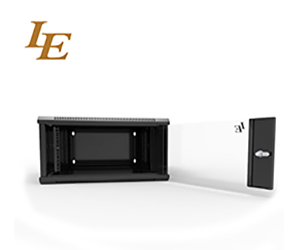
New technologies allow smart devices and sensors to generate huge volumes of actionable data in places like factories, stores, warehouses, hospitals and cell towers. This Internet of Things (IoT) has revolutionized applications ranging from optimizing assembly line production to delivering dynamically customized retail shopping experiences.
IoT, content delivery networks and 5G cellular communications have driven a fundamental shift in how and where data is processed. Centralized and cloud data centers can’t process so much data from so many places so far away so quickly. Doing it efficiently requires relocating computing resources like servers and storage to the network edge, where the data is generated.
In many edge computing locations, however, there is not a dedicated room for IT equipment, or hardly any space at all. Wall-mount rack enclosures provide secure, space-saving storage and organization for servers and network hardware inside locking steel cabinets, making them perfect for edge environments. These quick tips will help you select the perfect wall-mount rack for your specific application.
Each of your rack-mount devices will require a certain number of rack spaces, also known as rack units. A rack unit, or 1U, is a standard measurement 1.75 inches high. For example, servers typically require 1U to 3U each and edge network switches typically require 1U. Each wall-mount rack enclosure will specify its total number of available rack spaces. Choose a cabinet that has at least as many rack spaces as your equipment requires and strongly consider choosing one with extra space for future expansion.
Tip: If you also need to house some non-rack equipment, add a rack-mount shelf or choose a structured wiring enclosure.
Measure the depth of your deepest equipment and add 3 inches to allow for cabling. Wall-mount rack enclosures can accommodate mounting depths up to 36 inches, depending on model. Cabinets are also available in shallower depths to house equipment like patch panels without requiring as much space.
Tip: Some cabinets mount servers vertically or sideways to reduce how far the cabinet extends from the wall. For example, some models with 36-inch mounting depths extend less than 5 inches from the wall.
Add up the weight of all your equipment and make sure the listed weight capacity of the rack enclosure is larger.
Tip: The cabinet must be mounted securely to wall studs to support its full weight capacity.
Equipment in a location like a factory or warehouse may benefit from a NEMA 4 enclosure, which provides extra protection against dirt, dust, drips and splashes.
Wall-mount rack cabinets have perforated doors and side panels to allow ample airflow, but some locations may require additional cooling. Select models support adding electric fans or a special air conditioning unit that mounts to the top of the cabinet.
If your equipment will be housed in a secure location with controlled access, a wall-mount open frame rack may provide an economical alternative.
If you need to house rack-mount IT equipment in locations with limited space, visit Network Cabling system by Latitude's website to learn more.
Copyright © 2018 Latitude All Rights Reserved